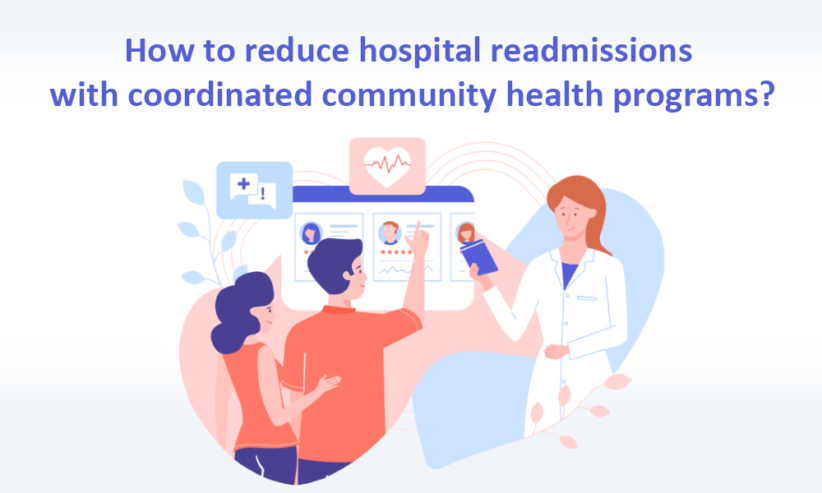(03) 9863 7644


How to reduce hospital readmissions with coordinated community health programs?
Hospital readmission rate is one of the key performance indexes used in the health care industry to gauge healthcare quality. However, unplanned hospital readmissions are becoming more prevalent in the Australian health care system in recent years. The good news is a significant percentage of these readmissions are avoidable with well-planned procedures and programs.
Readmissions are costly for hospitals as well as for patients’ health and wellbeing. Thus, the issue is one of the noteworthy challenges that is weakening the efficiency of the Australian healthcare system.
The Issue of hospital readmissions
Hospital readmission refers to the scenario when a patient who has been discharged from the hospital is readmitted to the hospital within a certain time interval. In general, hospital readmissions come under two broad categories:
-
Planned Readmissions (Readmissions related to routine care such as chemotherapy or dialysis that are required to ensure safe clinical care.)
-
Unplanned Readmissions
Professionals have identified multiple causes for hospital readmissions including, pressure for early discharge before the patient is adequately stable, recurrence or worsening of the initial condition, ageing population, multiple underlying medical comorbidities and improved survival in patients with chronic diseases. According to a study, the 90-day mortality rate is four times higher in patients with a 30-day readmission (Benuzillo et al, 2014), while $1.5 billion AUD is spent across Australia annually to treat readmitted hospital patients (Sahli, 2015).
Congestive heart failure is one of the most common health disorders related to unplanned hospital readmissions among Medicare participants. Other health problems associated with high readmission rates include cardiac dysrhythmias, septicemia, pneumonia, and chronic obstructive pulmonary disease (COPD).
On the other hand, frequent readmissions where 3 to 5 readmissions are recorded within 12 months of index admission could lead to the worst clinical outcomes, including higher mortality rates, worsened physical & mental health impacts, high cost for healthcare system and development of new impairments during and/or after hospitalization. According to studies, frequent readmission can increase a higher mortality rate by 2.5% and can manifest due to discharge against medical advice (DAMA), which includes scenarios such as delayed investigations, unclear diagnosis, incomplete treatment, and insufficient discharge plan and follow up.
As per Choi et al, 2011, frequent readmissions are commonly associated with young males with poor social support. Common conditions associated with readmissions include complications from alcohol abuse, diabetes, sepsis, skin & soft tissue infections, mood disorders.
Hospital readmissions rates in Australia
In Australia, rates of unplanned readmission within 28 days of hospital discharge are deemed to be an indicator of healthcare quality and safety, which records as
-
10.9% general medicine patients in South Australia in 2015
-
7.4% in Victoria in 2015
Moreover, 12-month frequent readmission rate in Australia is as high as 3.3%.
When considering the data, it’s clear that this is not an issue to take lightly. Fortunately, different literature materials on the subject show that many unplanned hospital readmissions are avoidable.
Reducing Hospital Readmissions
Although the hospital and its medical staff have control over only a few of the factors that trigger readmissions, hospitals are directly affected by the issue. Hospital readmissions negatively impact the opportunity to improve patient experience, better patient outcomes, lower costs and improve clinician experience, which has long been healthcare policy goals. Thus, it’s evident that hospitals can improve all the four above goals just by reducing this one thing – Hospital readmissions.
Luckily, there are so much hospitals can do to control some of the factors more efficiently and coordinate the rest with other institutions and individuals to reduce avoidable hospital readmissions.
Strategies for reducing Hospital Readmissions
Identifying causes, optimizing transitional care, and engaging patients are 3 prominent ways hospitals can reduce avoidable readmissions. For this, health care providers must develop clear plans to manage the discharge process and engage patients, not only to enhance quality, but be more supportive to patients as they transition through the care continuum.
Hospitals typically handle patient discharge focused on broad criteria such as by diagnosis and demographic with a one-size-fits-all approach from post-care to communication. Instead, hospitals must tailor their efforts to each patient's unique motives and attitudes toward health and wellness in order to reduce hospital readmissions. With a well-completed and actionable discharge summary at the point of discharge combined with an automated communication platform such as Dc2vue patient portal, hospitals can provide better support for successful post-discharge recovery.
Effective management of educational materials, recovery tracking, appointment reminders and medication adherence surveys, also aid health care professional to ensure more effective acute post care communication and coordination.
Increased collaboration with health care providers outside of the hospital, such as community nurses through coordinated community health programs, followed by a reliable home health monitoring (remote patient monitoring) system, is another main way to reduce readmissions. It is also vital that such collaboration take place with the patients themselves.
It’s clear focusing on avoidable hospital readmissions can reap many benefits for patients as well as for hospitals, including supporting better health outcomes, improving patient safety and cost and operational efficiency in the Australian healthcare system. Therefore, hospitals should pay attention to reducing hospital readmissions utilizing innovative technology and optimized post care programs.
Contact us to discuss how you might unpack these challenges with technology.





